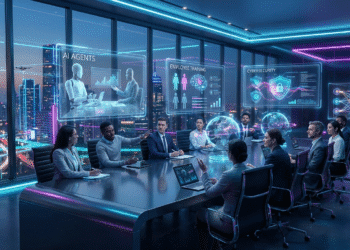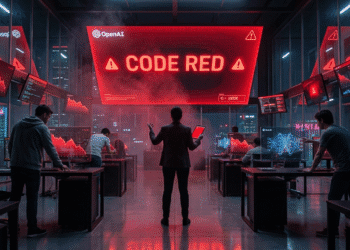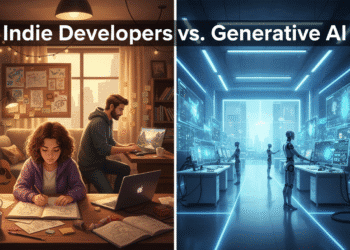The landscape of 3D content creation has undergone a seismic shift with the release of HunyuanWorld-1.0, Tencent’s groundbreaking open-source framework for generating immersive, explorable, and interactive 3D worlds from simple text descriptions or images.
Released on July 26, 2025, this revolutionary model represents the first open-source, simulation-capable 3D world generation system that promises to transform industries ranging from gaming and virtual reality to architectural visualization and educational content creation.
What Makes HunyuanWorld-1.0 Special?
Unlike traditional 3D generation approaches that focus on individual objects, HunyuanWorld-1.0 tackles the far more complex challenge of creating entire immersive environments. The model addresses a fundamental problem in computer vision and graphics: generating complete 3D worlds that are not only visually stunning but also functionally interactive and explorable.
The system stands out with three core innovations that set it apart from existing solutions:
360° Immersive Experiences
HunyuanWorld-1.0 leverages panoramic world proxies to create truly immersive 360-degree environments. This approach ensures that users can explore generated worlds from any angle without visual artifacts or inconsistencies that plague traditional methods.
Seamless Workflow Integration
The model’s mesh export capabilities provide unprecedented compatibility with existing computer graphics pipelines. This means developers and artists can seamlessly integrate generated worlds into established workflows using popular tools like Blender, Unity, or Unreal Engine.
Interactive Object Representation
Through disentangled object representations, the system enables augmented interactivity within generated worlds. Objects aren’t just visual elements—they can be manipulated, animated, and programmed to respond to user interactions.
The Technical Architecture Behind the Magic
At the heart of HunyuanWorld-1.0 lies a sophisticated architecture that combines panoramic proxy generation, semantic layering, and hierarchical 3D reconstruction. This innovative approach solves the longstanding challenge of balancing visual diversity with geometric consistency.
The framework operates through a semantically layered 3D mesh representation that uses panoramic images as 360° world proxies. This clever approach enables semantic-aware world decomposition and reconstruction, allowing the system to understand and organize different elements within a scene intelligently.
The generation process follows a two-stage pipeline:
Stage 1: Panoramic Proxy Generation
The system first creates high-quality panoramic images that serve as comprehensive visual blueprints for the 3D world. These panoramas capture the entire environmental context, including lighting, atmosphere, and spatial relationships between objects.
Stage 2: 3D World Reconstruction
Using the panoramic proxy, the model reconstructs a full 3D world with proper depth, geometry, and interactive elements. The semantic layering ensures that different objects and regions maintain their distinct properties while contributing to a cohesive whole.

Performance That Sets New Standards
HunyuanWorld-1.0’s performance metrics demonstrate its superiority over existing methods across multiple evaluation criteria. In comprehensive benchmarks comparing text-to-panorama generation capabilities, the model consistently outperforms established approaches like Diffusion360, MVDiffusion, PanFusion, and LayerPano3D.
For text-to-panorama generation, HunyuanWorld-1.0 achieved impressive scores:
- BRISQUE: 40.8 (lower is better)
- NIQE: 5.8 (lower is better)
- Q-Align: 4.4 (higher is better)
- CLIP-T: 24.3 (higher is better)
These metrics translate to significantly better visual quality and more accurate text adherence compared to competing methods.
In image-to-panorama generation tasks, the model similarly excels with a CLIP-I score of 85.1, indicating superior semantic consistency between input images and generated panoramic outputs.
Diverse Applications Across Industries
The versatility of HunyuanWorld-1.0 opens up revolutionary possibilities across numerous sectors:
Gaming and Interactive Entertainment
Game developers can rapidly prototype and generate diverse game environments, from fantastical alien landscapes to realistic urban settings. The model’s ability to create interactive, explorable worlds dramatically reduces development time and costs while enabling unprecedented creative freedom.
Virtual Reality and Metaverse Development
VR developers can leverage HunyuanWorld-1.0 to create immersive virtual environments for social platforms, training simulations, and entertainment experiences. The 360° immersive capabilities ensure that VR users experience seamless, artifact-free environments.
Architectural Visualization and Urban Planning
Architects and urban planners can quickly visualize proposed developments, create virtual walkthroughs of unbuilt spaces, and experiment with different design concepts. The model’s ability to generate realistic environments from text descriptions enables rapid iteration and client communication.
Educational and Training Applications
Educational institutions can create immersive learning environments for subjects ranging from history (recreating ancient civilizations) to science (visualizing molecular structures or astronomical phenomena). The interactive nature of generated worlds enables hands-on learning experiences.
Film and Media Production
Content creators can generate detailed background environments for films, commercials, and digital media projects. The mesh export capabilities ensure compatibility with existing production pipelines while significantly reducing the time and cost associated with environment creation.
Real Estate and Property Development
Real estate professionals can create virtual property tours, visualize development projects before construction, and provide clients with immersive experiences of properties under consideration.
Technical Implementation and Getting Started
For developers and researchers interested in exploring HunyuanWorld-1.0, the implementation process is straightforward but requires careful attention to system requirements and dependencies.
System Requirements
The framework requires Python 3.10 and PyTorch 2.5.0+cu124 for optimal performance. The model collection includes four specialized components:
- HunyuanWorld-PanoDiT-Text: Handles text-to-panorama conversion (478MB)
- HunyuanWorld-PanoDiT-Image: Manages image-to-panorama generation (478MB)
- HunyuanWorld-PanoInpaint-Scene: Provides scene inpainting capabilities (478MB)
- HunyuanWorld-PanoInpaint-Sky: Specializes in sky region enhancement (120MB)
Installation Process
The setup involves multiple dependencies including Real-ESRGAN for image enhancement, ZIM for object detection and segmentation, and Draco for optimized 3D mesh compression. The comprehensive installation process ensures all components work harmoniously together.
Usage Workflow
The typical workflow involves two primary steps:
- Panorama Generation: Convert text descriptions or input images into high-quality panoramic representations
- 3D World Creation: Transform panoramic images into fully interactive 3D environments with customizable object layering
Users can specify foreground object labels to control which elements appear as distinct, interactive layers versus background elements. This granular control enables precise customization of the generated environments.
Built-in Visualization and Interaction Tools
HunyuanWorld-1.0 includes a sophisticated ModelViewer tool that enables real-time visualization and interaction with generated 3D worlds directly in web browsers. This browser-based approach eliminates the need for specialized software and makes the technology accessible to a broader audience.
The viewer supports real-time navigation, object interaction, and dynamic lighting adjustments, providing users with immediate feedback on their generated environments. While hardware limitations may affect performance with particularly complex scenes, the tool offers an excellent preview of the model’s capabilities.
Addressing Current Limitations and Future Development
Like any cutting-edge technology, HunyuanWorld-1.0 faces certain limitations that the development team actively addresses. Hardware requirements can be substantial for complex scenes, and generation times may vary depending on scene complexity and desired quality levels.
The open-source roadmap includes several exciting developments:
- TensorRT optimization for improved performance
- RGBD video diffusion capabilities
- Enhanced mobile device compatibility
- Expanded model variants for specialized use cases
Performance Optimization and Best Practices
To achieve optimal results with HunyuanWorld-1.0, users should consider several best practices:
Prompt Engineering: Crafting detailed, specific text descriptions yields significantly better results than generic prompts. Including information about lighting conditions, architectural styles, and atmospheric effects helps the model generate more accurate environments.
Hardware Considerations: While the model can run on various GPU configurations, users with high-end hardware will experience faster generation times and can work with more complex scenes.
Iterative Refinement: The system supports iterative improvements, allowing users to refine generated worlds through multiple passes with adjusted parameters.
Impact on the 3D Content Creation Industry
HunyuanWorld-1.0’s release marks a pivotal moment in democratizing 3D content creation. Previously, creating immersive 3D environments required specialized skills, expensive software, and significant time investments. This technology reduces these barriers dramatically, enabling:
- Independent developers to create AAA-quality game environments
- Educational institutions to develop immersive learning experiences without massive budgets
- Small businesses to create virtual showrooms and interactive presentations
- Artists and designers to rapidly prototype and experiment with 3D concepts
The open-source nature of the release ensures that these benefits reach a global community of developers, researchers, and creators, fostering innovation and collaborative development.
Looking Toward the Future
HunyuanWorld-1.0 represents more than just a technological achievement—it signals a fundamental shift toward AI-assisted creativity in 3D content generation. As the model continues to evolve through community contributions and ongoing research, we can expect to see even more sophisticated capabilities emerge.
The integration of physical simulation capabilities hints at future developments where generated worlds won’t just look realistic but will also behave according to realistic physical laws. This could enable applications in engineering simulation, scientific modeling, and advanced gaming experiences that blur the line between virtual and reality.
The release of HunyuanWorld-1.0 establishes a new benchmark for what’s possible in AI-driven 3D world generation. By combining cutting-edge research with practical accessibility, Tencent has created a tool that promises to reshape how we think about and create digital environments. Whether you’re a game developer, architect, educator, or digital artist, HunyuanWorld-1.0 offers unprecedented capabilities to bring your creative visions to life in fully immersive, interactive 3D worlds.
As this technology continues to mature and the community of users grows, we’re likely witnessing the beginning of a new era in digital content creation—one where the only limit to creating incredible 3D worlds is human imagination itself.









